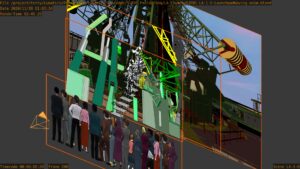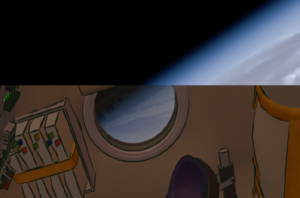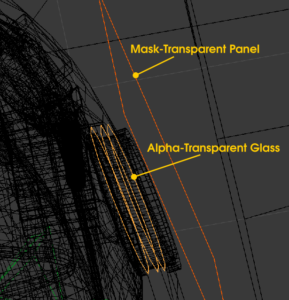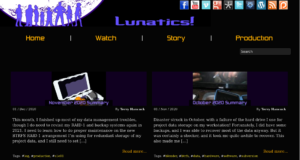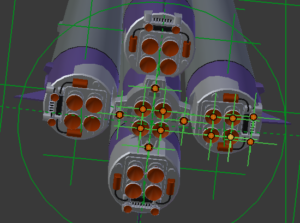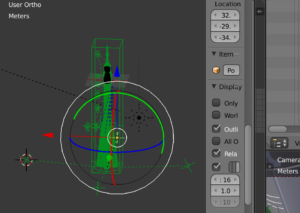HIGHLIGHTS:
TRAIN CAR
Revised the “Platz-Karny Vagon” train car model to incorporate alpha transparency so shots can be arranged for compositing between inside and outside elements.
SOYUZ ORBITER
Applied the same window technique to the Soyuz Orbiter for alpha compositing. Then converted the constraints-based control rig to an armature system, as I’ve done with Chris Kuhn’s other models.
2.5D WAVING SHOT
Completed the cel drawings for S1E01-LA-1-D, which shows the three space travelers waving to the assembled crowd before getting on Soyuz.
ROCKET PLUME EFFECT
Settled on what I think will be the final version of the rocket plume animation effect.
SOYUZ LAUNCH VEHICLE
Started converting the constraints-based rig to an armature control panel. Ran into some trouble with the shroud control, and continuing the work in January.
Dec 1, 2020 at 4:00 PM
One “2.5D” Shot
Early in the planning phases, before I knew what resources we’d have, I had planned to do most of the launch sequence using flat “cels”, reserving the 3D work for later. That was before Chris Kuhn joined the project and provided us with the wonderful mech models for the Soyuz launch system.
So, in the end, this shot of the astronauts waving to the crowd just before boarding their spacecraft is the only remaining 2D composited shot (the main characters and the steps they are standing on are 3D, but everything else is 2D cels).
Unlike my previous “cel animation” projects, this uses a perspective camera to correctly capture the 3D characters.
The background panel is a render of the 3D launchpad set.
The reason to go back to this is that the model isn’t quite accurate for this part of the launchpad, and it was much faster to simply make 2D art based on a photo than to try to alter the 3D set model.
Dec 10, 2020 at 4:00 PM
Mask Transparency for Compositing
For a couple of shots in the pilot, I’m using separate interior and exterior compositions which will be composited together either in “post-compositing” (Blender) or “video editing” phases (Kdenlive).
In Blender we can use “mask transparency” sort of like a blue or green screen effect, to achieve this result.
This shows the effect, simulated in Inkscape by simply putting the 3D rendered PNG in front of a background image.
You’ll note that not only can we see the background, but we can still see the reflections of the interior on the glass. This is because the mask-transparent panel is behind the “glass” in the interior model.
Here’s what this looks like in the interior set model:
Dec 20, 2020 at 4:00 PM
Yet Another Try on the Rocket Plume
I keep experimenting with these flame effects.
I spent quite awhile trying to figure out a way to make the plume have a “delayed follow” effect, where the end of the plume would take a little time to catch up with the rocket nozzle changing direction.
But then I did a little back-of-the-envelope estimating, and realized that this effect would really be about a 0.01s delay — or around one-third of a frame. So, really, it’s better to just ignore it, and have the plume move like a solid object. Intuitively, just think of how a blow torch acts, rather than a guttering flame.
So I went back to this much-simpler approach, which just combines mesh scaling and a moving texture.
It consists of three plume meshes, with a moving texture, to which I applied a four-level ramp (no interpolation), to give it more of a “toon” look. Of course, this will be duplicated for each rocket nozzle.
I’m going to make some changes to how it’s rigged, but I think this look is probably adequate.
Dec 23, 2020 at 4:01 PM
Completed Rocket Plume Effect (I Think)
I tweaked the color and texture a bit, and added an animation armature for the meshes, with a noise animation to make the end flutter. I’ve also included the sound effect (which is an actual recording from a Soyuz launch).
I think this will do. Of course, this will be duplicated and scaled to match the rocket nozzles — both the main rockets and the verniers. All together that is 40 nozzles on the booster stage of the Soyuz, counting the quad-nozzles on the main engines and the four vernier motors on the core and pod stages. I figure if the animation is shifted so they don’t move exactly in sync, that should look fairly convincing.
Dec 29, 2020 at 4:14 PM
Monthly Summaries Migrated to Production Log
After discovering that I can backdate posts on my self-hosted WordPress production site, I started collecting monthly summary posts and posting them back-dated to the 1st of the next month. I’ve worked my way back from last month’s (November 2020) to January 2019.
These collect highlights from my worklogs, along with the Patreon posts for that month.
I’m going to start adopting this as my standard workflow for project posts in 2021: I will continue to post them initially here, then, as they go public, I will collect them into monthly summaries on the Production Log, with a little light editing, and additions from my worklog of minor stuff I didn’t post about here.
I think this serves the goal of putting premium up-to-date content here on Patreon for patrons, while keeping a permanent project record on our main website.
Dec 30, 2020 at 4:01 PM
Transferring Positions for Rocket Plume Effects
Here I’m just creating empties in the Launch Vehicle model to match the locations of the rocket engine bells, so I can construct the flame plume effect to match (the orange dots show the empties that will be used for this).

